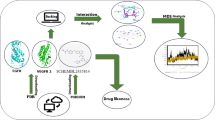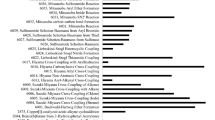Abstract
Survivin is an apoptosis suppressing protein linked to different forms of cancer. As it stands, there are no approved drugs for the inhibition of survivin in cancer cells despite a number of promising compounds in clinical trials. This study designed a new set of compounds from fragments of active survivin inhibitors to potentiate their binding with survivin at BIR domain. Three hundred and five (305) fragments made from eight potent inhibitors of survivin were reconstructed to form a new set of compounds. The compounds were optimized using R group enumeration and bioisostere replacement after extensive docking analysis. The optimised compounds were filtered by a validated pharmacophore model to reveal how well they are aligned to the pharmacophore sites. Molecular docking of the well aligned compounds revealed the top-scoring compounds; and these compounds were compared with the eight inhibitors used as template for fragment-based design on the basis of binding affinity (rigid and flexible docking), predicted pIC50 and intermolecular interactions. The electronic behaviours (global descriptors, HOMO/LUMO, molecular electrostatic potential and Fukui functions) of newly designed compounds were calculated to investigate their reactivity and atomic sites prone to neutrophilic/electrophilic attack. The nine newly designed compounds had better rigid and flexible docking scores, free energy of binding and intermolecular interactions with survivin at BIR domain than the eight active inhibitors. Based on frontier molecular orbitals, OPE-3 was found to be the most reactive and less stable compound (0.13194 eV), followed by OPE-4 and OPE-9. The global descriptive parameters showed that OPE-3 had highest softness value (7.5245 eV) while OPE-8 recorded the maximum hardness value (0.08486 eV). The well-validated QSAR model also showed that OPE-3, OPE-7 and OPE-8 had the most significant bioactivity of all the inhibitors. This study thus provides new insight into the design of compounds capable of modulating the activity of survivin.






Similar content being viewed by others
Availability of data and material
All data generated in this study have been included in the article and supplementary material
Abbreviations
- DFT:
-
Density functional theory
- PDB:
-
Protein data bank
- QSAR:
-
Quantitative structure active relationship
- BIR:
-
Baculovirus IAP repeat
- SMAC:
-
Secondary mitochondria activator of caspase
- DIABLO:
-
Direct IAP binding protein with low pI
- IAP:
-
Inhibitors of the apoptotic proteins
- OPLS:
-
Optimized potentials for liquid simulations
- HOMO:
-
Highest occupied molecular orbital
- LUMO:
-
Lowest unoccupied molecular orbital
- IFD:
-
Induced fit docking
- XP:
-
Extra precision
References
Alenzi FQB (2004) Links between apoptosis, proliferation and the cell cycle. Br J Biomed Sci 61(2):99–102
Andersson T, Broo A, Evertsson E (2014) Prediction of drug candidates’ sensitivity toward autoxidation: computational estimation of CH dissociation energies of carbon-centered radicals. J Pharm Sci 103(7):1949–1955
Beardmore VA, Ahonen LJ, Gorbsky GJ, Kallio MJ (2004) Survivin dynamics increases at centromeres during G2/M phase transition and is regulated by microtubule-attachment and Aurora B kinase activity. J Cell Sci 117(18):4033–4042
Behera DK, Behera PM, Acharya L, Dixit A (2017) Pharmacophore modelling, virtual screening and molecular docking studies on PLD1 inhibitors. SAR QSAR Environ Res Engl 28(12):991–1009
Bray F, Ferlay J, Soerjomataram I, Siegel RL, Torre LA, Jemal A (2018) Global cancer statistics 2018: GLOBOCAN estimates of incidence and mortality worldwide for 36 cancers in 185 countries. CA Cancer J Clin 68(6):394–424
Mary YS, Mary YS, Krátký M, Vinsova J, Baraldi C, Cristina Gamberini M (2021) Concentration dependent SERS, DFT and molecular docking studies of a ureido derivative with antitubercular properties. Spectrochim Acta A Mol Biomol Spectrosc 15(249):119329
Deveraux QL, Reed JC (1999) IAP family proteins—suppressors of apoptosis. Genes Dev 13(3):239–252
Dhanabalan AK, Kesherwani M, Velmurugan D, Gunasekaran K (2017) Identification of new BACE1 inhibitors using pharmacophore and molecular dynamics simulations approach. J Mol Graph Model 76:56–69
Elekofehinti OO, Iwaloye O, Famusiwa CD, Akinseye O, Rocha JBT (2020) Identification of main protease of coronavirus SARS-CoV-2 (Mpro) inhibitors from Melissa officinalis. Curr Drug Discov Technol 17
Erlanson DA, Davis BJ, Jahnke W (2019) Fragment-based drug discovery: advancing fragments in the absence of crystal structures. Cell Chem Biol 26(1):9–15
Fang G, Xu L, Cao Y, Li A (2016) Theoretical design and computational screening of precursors for atomic layer deposition. Coord Chem Rev 322:94–103
Fradera X, Methot JL, Achab A, Christopher M, Altman MD, Zhou H et al (2019) Design of selective PI3Kδ inhibitors using an iterative scaffold-hopping workflow. Bioorg Med Chem Lett 29(18):2575–2580
Fukuda S, Pelus LM (2006) Survivin, a cancer target with an emerging role in normal adult tissues. Mol Cancer Ther 5(5):1087–1098
Hagenbuchner J, Oberacher H, Arnhard K, Kiechl-Kohlendorfer U, Ausserlechner MJ (2019) Modulation of respiration and mitochondrial dynamics by SMAC-mimetics for combination therapy in chemoresistant cancer. Theranostics 9(17):4909
Hanahan D, Weinberg RA (2000) The hallmarks of cancer. Cell 100(1):57–70
Iwaloye O, Elekofehinti OO, Kikiowo B, Fadipe TM, Akinjiyan MO, Ariyo EO et al (2020) Discovery of traditional Chinese medicine derived compounds as wild type and mutant Plasmodium falciparum dihydrofolate reductase inhibitors: induced fit docking and ADME studies. Curr Drug Discov Technol 17
James N, Shanthi V, Ramanathan K (2020) Density functional theory and molecular simulation studies for prioritizing anaplastic Lymphoma kinase inhibitors. Appl Biochem Biotechnol 190(4):1127–1146
Kanwar JR, Kamalapuram SK, Kanwar RK (2013) Survivin signaling in clinical oncology: a multifaceted dragon. Med Res Rev 33(4):765–789
Khalid M, Ullah MA, Adeel M, Khan MU, Tahir MN, Braga AAC (2019) Synthesis, crystal structure analysis, spectral IR, UV–Vis, NMR assessments, electronic and nonlinear optical properties of potent quinoline based derivatives: interplay of experimental and DFT study. J Saudi Chem Soc 23(5):546–560
Kikiowo B, Ogunleye JA, Iwaloye O, Ijatuyi TT (2020) Therapeutic potential of Chromolaena odorata phyto-constituents against human pancreatic α-amylase. J Biomol Struct Dyn 1–12
Kumar V, Roy K (2020) Development of a simple, interpretable and easily transferable QSAR model for quick screening antiviral databases in search of novel 3C-like protease (3CLpro) enzyme inhibitors against SARS-CoV diseases. SAR QSAR Environ Res 31(7):511–526
Kumar A, Rathi E, Kini SG (2019) E-pharmacophore modelling, virtual screening, molecular dynamics simulations and in-silico ADME analysis for identification of potential E6 inhibitors against cervical cancer. J Mol Struct 1189:299–306
LaCasse EC, Baird S, Korneluk RG, MacKenzie AE (1998) The inhibitors of apoptosis (IAPs) and their emerging role in cancer. Oncogene 17(25):3247–3259
Li Q (2020) Application of fragment-based drug discovery to versatile targets. Front Mol Biosci 7
Li F, Aljahdali I, Ling X (2019) Cancer therapeutics using survivin BIRC5 as a target: what can we do after over two decades of study? J Exp Clin Cancer Res 38(1):368
Martínez-García D, Manero-Rupérez N, Quesada R, Korrodi-Gregório L, Soto-Cerrato V (2019) Therapeutic strategies involving survivin inhibition in cancer. Med Res Rev 39(3):887–909
Peery RC, Liu J-Y, Zhang J-T (2017) Targeting survivin for therapeutic discovery: past, present, and future promises. Drug Discov Today 22(10):1466–1477
Pierce AC, Rao G, Bemis GW (2004) BREED: generating novel inhibitors through hybridization of known ligands. Application to CDK2, p38, and HIV protease. J Med Chem 47(11):2768–2775
Quispe PA, Lavecchia MJ, León IE (2019) On the discovery of a potential survivin inhibitor combining computational tools and cytotoxicity studies. Heliyon 5(8):e02238
Rafatmanesh A, Behjati M, Mobasseri N, Sarvizadeh M, Mazoochi T, Karimian M (2020) The survivin molecule as a double-edged sword in cellular physiologic and pathologic conditions and its role as a potential biomarker and therapeutic target in cancer. J Cell Physiol 235(2):725–744
Sattarinezhad E, Bordbar A-K, Fani N (2015) Piperine derivatives as potential inhibitors of survivin: an in silico molecular docking. Comput Biol Med 63:219–227
Shusterman AJ, Shusterman GP (1997) Teaching chemistry with electron density models. J Chem Educ 74(7):771
Song Z, Yao X, Wu M (2003) Direct interaction between survivin and Smac/DIABLO is essential for the anti-apoptotic activity of survivin during taxol-induced apoptosis. J Biol Chem 278(25):23130–23140
Tai W, Lu T, Yuan H, Wang F, Liu H, Lu S et al (2012) Pharmacophore modeling and virtual screening studies to identify new c-Met inhibitors. J Mol Model 18(7):3087–3100
Tripathi AC, Sonar PK, Rathore R, Saraf SK (2016) Structural insights into the molecular design of HER2 inhibitors. Open Pharm Sci J 3(1)
Tu SP, Jiang XH, Lin MCM, Cui JT, Yang Y, Lum CT et al (2003) Suppression of survivin expression inhibits in vivo tumorigenicity and angiogenesis in gastric cancer. Cancer Res 63(22):7724–7732
Verdecia MA, Huang H, Dutil E, Kaiser DA, Hunter T, Noel JP (2000) Structure of the human anti-apoptotic protein survivin reveals a dimeric arrangement. Nat Struct Biol 7(7):602–608
Verhagen AM, Ekert PG, Pakusch M, Silke J, Connolly LM, Reid GE et al (2000) Identification of DIABLO, a mammalian protein that promotes apoptosis by binding to and antagonizing IAP proteins. Cell 102(1):43–53
Wadegaonkar VP, Wadegaonkar PA (2013) Withanone as an inhibitor of survivin: a potential drug candidate for cancer therapy. J Biotechnol 168(2):229–233
Wang J, Li W (2014) Discovery of novel second mitochondria-derived activator of caspase mimetics as selective inhibitor of apoptosis protein inhibitors. J Pharmacol Exp Ther 349(2):319–329
Wang Y, Xiao J, Suzek TO, Zhang J, Wang J, Zhou Z et al (2012) PubChem’s BioAssay database. Nucleic Acids Res 40(D1):D400–D412
Wang Q, Arnst KE, Xue Y, Lei Z-N, Ma D, Chen Z-S et al (2018) Synthesis and biological evaluation of indole-based UC-112 analogs as potent and selective survivin inhibitors. Eur J Med Chem 149:211–224
Xiao M, Li W (2015) Recent advances on small-molecule survivin inhibitors. Curr Med Chem 22(9):1136–1146
Xiao M, Wang J, Lin Z, Lu Y, Li Z, White SW et al (2015) Design, synthesis and structure-activity relationship studies of novel survivin inhibitors with potent anti-proliferative properties. PLoS ONE 10(6):e0129807
Acknowledgements
The authors acknowledge the technical support received from Computational Biologists at Bioinformatics and Molecular Biology Unit, Department of Biochemistry, Federal University of Technology, Akure, Ondo State, Nigeria.
Funding
None.
Author information
Authors and Affiliations
Contributions
OE: Project drafting, provision of resources for research and manuscript revision; IO: Conception and implementation of the in silico experiment, generation and analysis of data, interpretation of data and preparation of manuscript draft; OF: Project design, data acquisition and preparation of manuscript draft; PC: Manuscript draft and substantial manuscript revision; IMF: substantial manuscript revision. All authors read and approved the manuscript before submission.
Corresponding author
Ethics declarations
Ethical approval and consent
No ethical clearance is required for the research
Consent of Publication
Not applicable
Conflict of Interest
The authors declare no conflict of interest, financial or otherwise.
Additional information
Publisher's Note
Springer Nature remains neutral with regard to jurisdictional claims in published maps and institutional affiliations.
Supplementary Information
Below is the link to the electronic supplementary material.
Rights and permissions
About this article
Cite this article
Elekofehinti, O.O., Iwaloye, O., Olawale, F. et al. Newly designed compounds from scaffolds of known actives as inhibitors of survivin: computational analysis from the perspective of fragment-based drug design. In Silico Pharmacol. 9, 47 (2021). https://doi.org/10.1007/s40203-021-00108-8
Received:
Accepted:
Published:
DOI: https://doi.org/10.1007/s40203-021-00108-8




